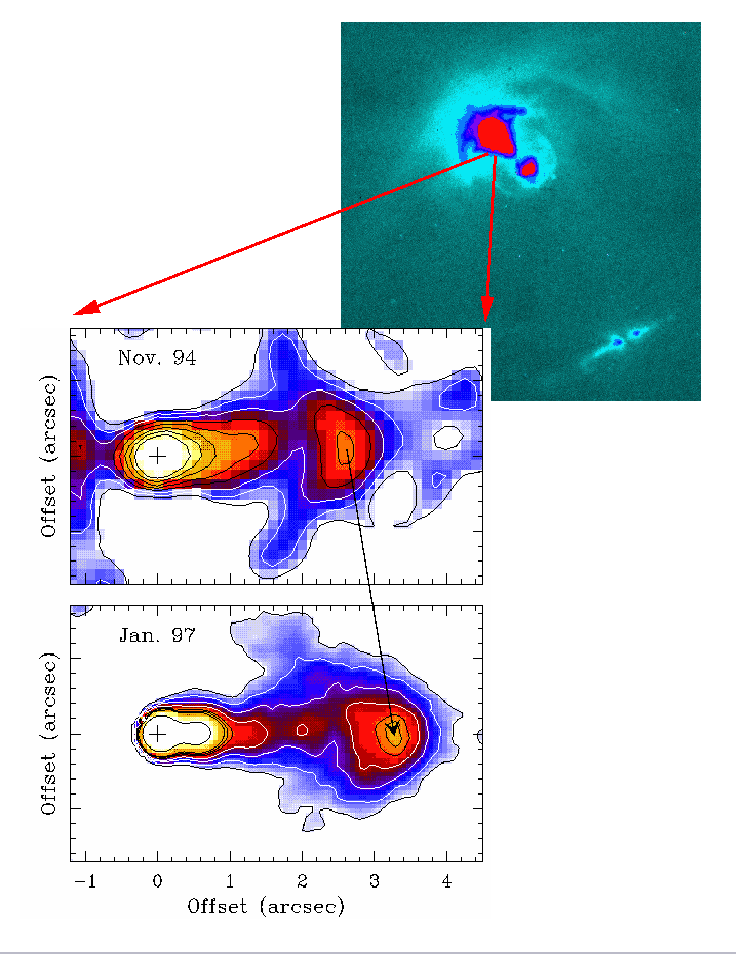Stars come in a variety of flavors: from young to old, and
from well-behaved to bad-tempered. As for many humans, stars in their
youth exhibit many contradictory and exhuberant behaviours that are
inherent to their formation process.
This week's image features DG Tauri, a 2 million year old star that is
currently forming in a large molecular cloud located in the
constellation Taurus. To gather enough material to reach its "adult"
mass, a star must accrete dust and gas from the nearby medium. That's
common sense! Starting from nothing, the star has to grow by accreting
from its neighbourhood. Signatures of this process are well identified
in the so-called T Tauri stars, a group of young solar-like stars to
which DG Tauri belongs.
Contradictory to this picture of mass accretion, many young stars also
lose mass at the same time, sometimes dramatically.
Astronomers can witness and study a fine example of this dual
phenomenon of simultaneous mass loss and mass accretion in DG
Tauri. This week's featured images were obtained with two of CFHT's
leading instruments: CFH12k, the prime focus wide-field imager, and
PUEO, the high resolution adaptive optics imager. On the large scale
CFH12k image (at top right), DG Tauri is visible, together with its
surrounding nebulosity and jet outflow. DG Tauri is actually hidden
inside the bright red spot, together with a jet (seen in the
insert). These and other features of the DG Tauri environement are
identified here.
At the bottom of this image, DG Tauri B, the young companion of DG
Tauri is also showing signs of mass loss! Indeed, a fine streak of
material, a bipolar jet, is also clearly visible on both sides of a
zone apparently devoid of material. In reality, DG Tauri B is hidden
inside , in a dust cocoon dense enough to make the star invisible in
this wavelength range.
A closer view of the inner parts of DG Tauri, close to the base of the
arrows, is presented in the insert, at bottom left. This high resolution image shows
details of the ionised outflow
close to the star. The stellar position is indicated by the cross and
a large emission knot, tracing emission of a shock as the outflow rams
into previously ejected material, is seen at two different
epochs. Clearly the shock front is moving outward with a large
velocity (200 km/s). Another strong shock is also seen farther out in
the CFH12k image, to the lower-right of DG Tauri. The presence of such
strong shocks within the outflow is interpreted as signs of
variability in the ejection process.
Technical description:
The wide-field image of DG Tauri and DG Tauri B is presented here
for the first time. It was obtained during a survey of Taurus cloud
by the Astronomers of the CFHT corporation. The image was obtained in
a filter centered on the Hydrogen H-alpha line. This emission line
is a good tracer of shock emission and a powerful tool to seearch for
mass loss. Exposure time was 20 minutes in this single image obtained
in January 2000.
The insert images were obtained with the PUEO adaptive optics systems
in January 1997 and TIGER imaging spectrograph in November 1994. The
images were obtained in a forbidden emission line of Oxygen centered at
630nm in both cases. Exposure time were typically 20 minutes with PUEO.




